Introduction
In the last blog, I used acceleration due to gravity as an example to introduce the concept of fields. In this blog, we will finish the discussion of gravitational fields and move the concepts from gravitational to electric fields. We will also finally answer the question “Is there anything in a field?”
What is a Field?
In physics, a field is a two or three-dimensional region that has a specific and measurable value at every location. It’s not necessary, or even logistically possible, to measure the value at each location, but a measurable value exists at every position. In the last blog, I used colors to indicate small changes in acceleration at 800 randomly selected points on the Earth’s surface.

This three-dimensional vector field shows the direction and magnitude of acceleration at equally spaced points near the surface of the Earth. The rainbow colors indicate the relative difference from average acceleration, with redder arrows indicating greater acceleration magnitude near the poles and purple indicating lower acceleration magnitude near the equator.
Vector Fields
While colored arrows make for a visually interesting graphic, it is impossible to do any sort of meaningful math with colors. The magnitude of the acceleration needs a different graphical representation, and the obvious (and perhaps only) answer is to use the length of the arrows to indicate the magnitude of the acceleration

In this image, 1600 arrows represent local gravitational acceleration at points around the Earth’s surface. Arrows are longer in areas where the acceleration is higher than average and shorter in areas where the acceleration is lower than average. The length of the arrows is exaggerated with respect to the actual acceleration, otherwise, the length of the arrows would only vary by one part in two hundred, which would not be noticeable.
Now For the Philosophical Questions
The question “Is there gravity in the physical space around a single massive object if there are no other objects nearby?” is similar to the question “If a tree falls in the forest and no one is around to hear it, does it make a sound?”
These metaphysical questions make you momentarily stumble because each question takes advantage of innate assumptions about interaction and then removes a necessary second object from the discussion. A better question might be “Does the region of space around a massive object have different object properties than if that massive object wasn’t there?”
The answer is yes – the region of space around the Earth certainly has different properties than if the Earth wasn’t there.
Proof that mass alters space
In Einstein’s Theory of Relativity, massive objects distort space and time.
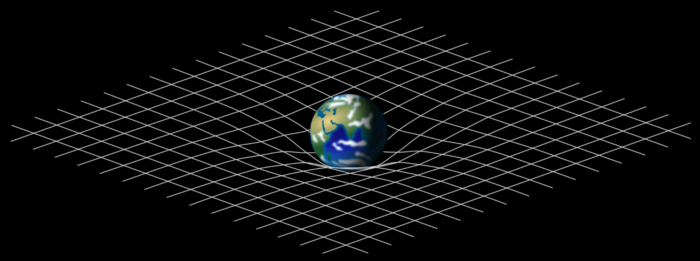
Image of planar grid deformed by a planetary mass from Wikipedia.com
Einstein’s theories are backed by astronomical observations. Large masses can alter spacetime and warp the path of electromagnetic waves to create a gravitational lens that alters the path of light in a similar way that a galaxy-sized optical lens would.

Above is a Hubble-telescope visible-light image of the galaxy cluster Cl 0024+17 (ZwCl 0024+1652) If you look closely towards the center of the image, you will notice that some galaxies near the center of the image appear multiple times. This is the result of a gravitational lens effect caused by a large mass between the telescope and the galaxies that bends the path of light. Image from nasa.gov
Einstein also predicted that any information about changes in the location of our imagined object or the position of Earth propagates outwards at the speed of causality (the speed of light 3 x 108(m/s)).
Mass does alter the properties of space-time, and when the mass moves, the information travels outwards at the speed of causality. It takes some amount of time for the changes in the field configuration to propagate outwards.
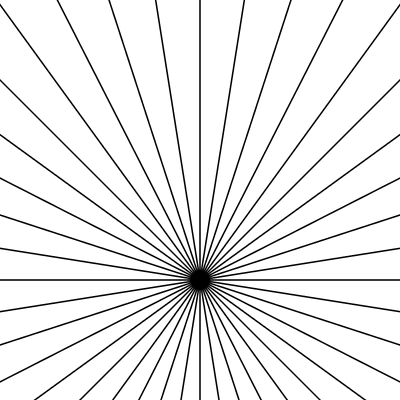
This artistic impression of the radiating field lines surrounding an object as it accelerates through space. The information about the changes in the field updates at a fast, but finite speed of 3 x 108(m/s).
In September of 2015, scientists confirmed this portion of Einstein’s relativity theory when they detected gravitational waves caused by two colliding black holes.
Physically, there is of course a difference between electromagnetic and gravitational fields. But the underlying mathematics is quite similar.
Electric Fields
“Does the region of space around a charged object have different object properties than if that charged object wasn’t there?” is a more difficult question to answer than the question about mass and acceleration due to gravity.
From the day you were born, you’ve experienced the effects of Earth’s gravity first-hand. But you seldom experience the effects of electrostatic attraction and repulsion.
Electric charge is a mutable object property. Objects might possess a positive charge, a negative charge, or a net-zero charge at any moment as they acquire and lose excess electrons. That makes the behavior of the objects non-uniform: objects sometimes repel; objects sometimes attract; objects sometimes don’t interact at all.
But outside of carefully designed experiments, or when large amounts of electric charge are accidentally stored on your body as you walk across a carpeted floor, there aren’t very many opportunities for you to experience an electric force in your day-to-day life. That means it is difficult to develop intuition about the behavior of charged objects. The closest analog might be playing with magnets.
While you do need two objects to experience a force, you only need one object to perturb a region of space. Mass is an object property that perturbs space in one particular way. Electric charge is an object property that perturbs space in a different way.
The idea that space is altered by the presence of a charge is the basis for the idea of an Electric Field.
Electric fields exist in a region of space around a charged object. The field for a single charged object is given by the equation

Since there are positive and negative charges, field vectors can point towards or away from the charged object. By convention, vectors point away from positive charges and towards negative charges.
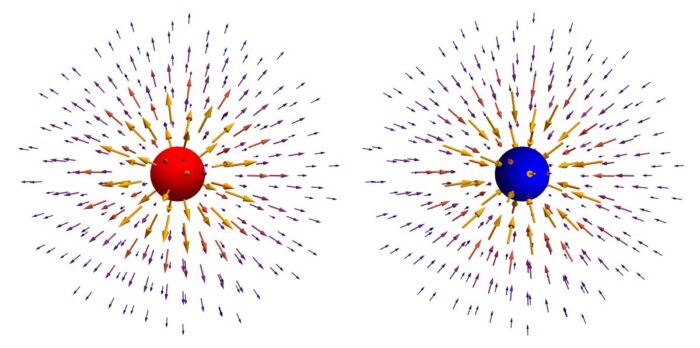
In this image, the electric field lines point away from a positively charged object (red, left) and towards a negatively charged object (blue, right)
The electric field intensity increases as the charge increases and the electric field intensity decreases as you move further away from an object.
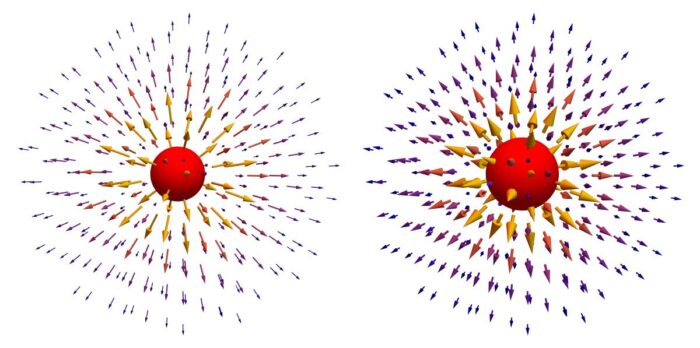
In this image, larger amounts of charge are indicated by large spheres. The amount of charge affects the strength of the electric field, represented by the arrow diameter.
Electric Field Around Multiple Charges
By convention, electric fields start at positive charges and end at negative charges.

This image shows the three possible charge pair scenarios. On the left, electric field arrows point from positive (red) towards negative (blue). In the middle, the positive charges repel and on the far right, the negative charges repel.
And since drawing all those little arrows can be cumbersome and confusing, it’s far more common to see continuous lines that extend from one charge to another. It is important to remember that these lines do not show the path that charges take from point to point, they are just simplifications of a potentially overwhelming vector field plot.
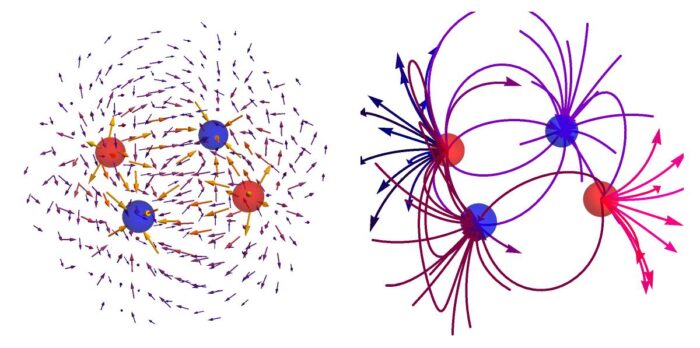
In the image above, the number of vector arrows on the left hides the nature of the field lines. Generally, a smaller number of “field lines” are drawn (on right) to show the general trend amongst the individual arrows. Unfortunately, the field lines give the impression that they are streamlines and define the path a charge will follow at a given point. Free charges do not follow the curves. At any given point in space, charges will experience a force in the direction tangent to the curve.
Electric fields are not electric forces. But they establish a mathematical and physical framework in a region of space should additional charges appear. As soon as another charged object is brought into that region of space where the first charged particle exists, the charges will interact and experience a shared force.
Summary
Hopefully, this blog has joggled enough neurons that some of your college physics is rushing back to you. Here are the important points: fields are mathematical models that define the magnitude of a particular object property at all locations in space; changes in the field propagate outwards at a fast, but finite speed; and, field-lines are shortcuts that allow us to avoid drawing an insane number of vectors.
In the next blog in the series, we’ll take a look at charge polarization



